Watering Indoor Plants properly is one thing you must learn to grow contented houseplants. The results For your plants make all the difference between a happy and sad houseplant.
We put together this information sheet and tip guide for watering plants to help you troubleshoot and improve this critical part of your plant care.
The most important part of nurturing a houseplant is learning what it needs and how to give it to the plant.
This post will help you Learn about the right water to use for plants, what affects plant soil drying, overwatering, unerwatering, and the best watering methods to correctly water your houseplants.
Open the Table of Contents tab below to find an outline of these topics. you can click and jump to your area of interest.
….Or read the whole post to see all you need to know about properly watering your plants.
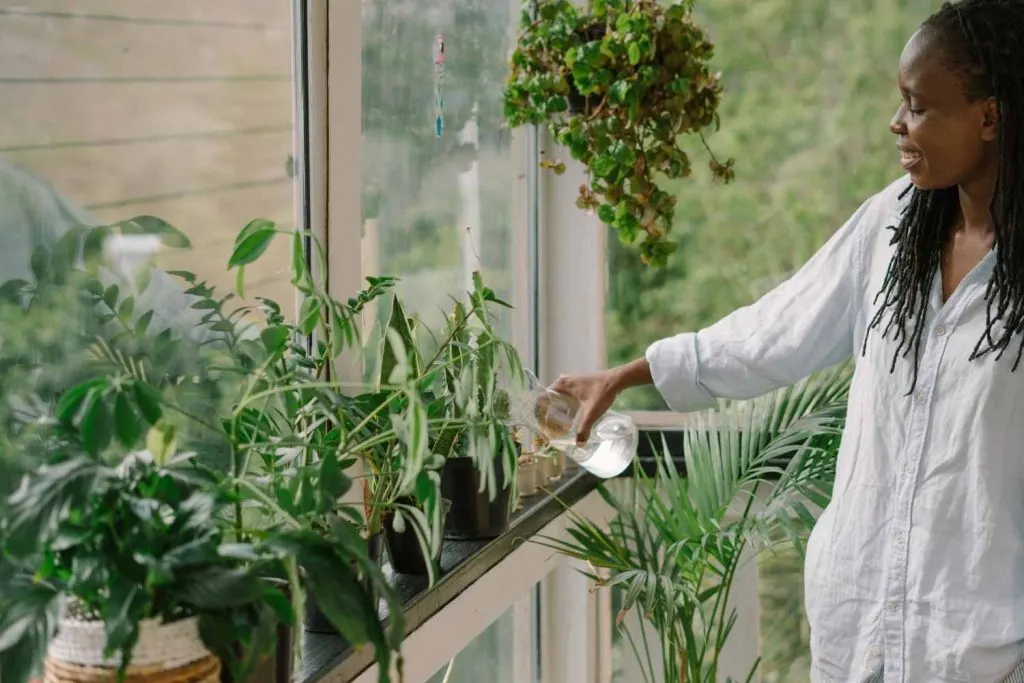
Why is Watering Plants such a big deal?
Watering Causes More Problems for Indoor Plants than anything else we do for them.
All the Pothos Vines, Philodendrons, and many other durable houseplants we suggest for beginner plant parents adjust themselves to most watering conditions we throw at them. In the short term. In the long run….
Even the most easy going houseplant needs correct watering practices. Or, eventually, it will show signs of watering stress.
Plants Watering Stress- Yellowing Leaves:
Is your plant soil always wet? Or always dry? Plant will suffer stress in both conditions. Look for these signs of stress.
Signs of Watering Stress:
- Yellowing Leaves-Read our post on Seven Reasons Your Plant Has Yellowing leaves for more on yellowing leaves.
- brown or dry leaf tips– most often this means underwatering or low humidity.
- drooping leaves-overwatering is usually the culprit
- faded colors or mushy leaves– especially true with succulents. This Post on properly watering succulents will guide you on arid loving plants.
- dropping leaves or falling over plant. This indicates very sickly plant roots. Learn how to fix root rot here.
These are all signs of incorrect watering. We’ll get into how often to water plants below. But first we need to make sure we are using the correct water for the plants in our homes.
Best water for houseplants:
Distilled water is the safest all purpose water for all indoor plants.
My Calathea collection has taught me about the importance of the correct water for indoor plants. Calatheas, are very sensitive.
My well water is too high in PH and minerals for my sensitive Calatheas. I lost my first Calathea before I learned. Sorry Pinstripe. 🙁
So I’ll pass on what I learned and save you a few plant problems.
However, Some houseplants will tolerate almost any water. Pothos, snake plants, zebra plants, asparagus fern, peace lily and Ficus Benjamina all live at my house and tolerate my well water without any signs of stress.
So it pays to learn your plants. Which ones need low mineral, no chemical and low PH water to thrive? Our plant care guides will tell you.
What is in your Water?
The water you use makes a difference to some houseplants. Not so much in others. But all of your houseplants might do better with proper water.
This is especially important if your are using hydroponics or semi hydroponics (like LECA Clay balls). Plants with a water substrate feeding system depend on a good exchange of nutrients through the water you use. The PH, and mineral content of your water impacts this.
Plants can be poisoned by poor water. If the roots are smothered, burned or damaged by improper water test your water.
- WELL WATER- It is often too high in both minerals and PH for houseplants.
- WATER SOFTENERS-They are high in sodium. This is toxic to plants.
- MUNICIPAL WATERS- They can contain harsh chemicals your plants may find toxic.
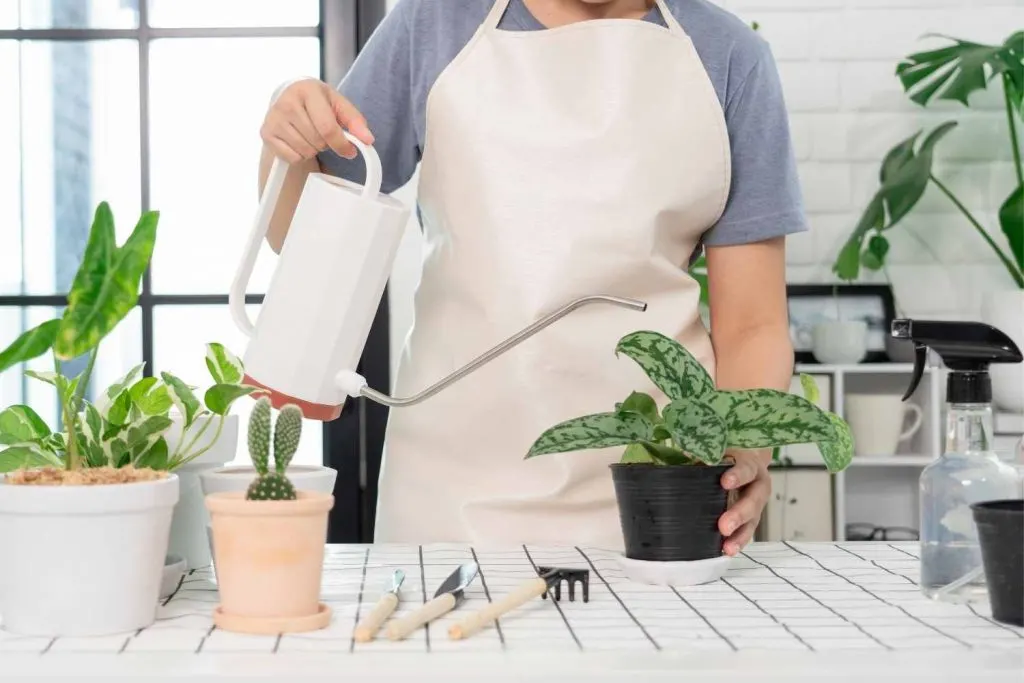
To find out if your water quality is causing problems for your houseplants, Test Your Water.
Solutions For Improper water :
Distilled water, filtered water and rain water are considered safe for all houseplants. They have a neutral to slightly acidic PH, fewer chemicals and salts and are lower in minerals than well water or some Municipal Tap water.
- Test your tap water PH with a cheap aquarium PH test kit. If you have high ph readings (over 7 on your test kit) you can bring the ph down to the plant happy zone of 5.5 to 6.5. with PH Down.
- Collect Rain water. Rain water is usually low mineral and low PH. Just what your plants need. And it costs you nothing. But be sure to test it. It may be picking up minerals and ph from the roof it is running off.
- Add a charcoal filter system to your faucet to help remove harmful chemicals and filter your plant water.
- Use distilled water.
Do you Need a Watering Schedule ?
No. If you water your houseplants by the calendar. you are going to eventually have some unhealthy plants. Not all plants need water on the same schedule. And a schedule will lead you astray eventually. The soil. season of the year, local climate, pot size and plant type all play into watering needs.
Look at the houseplant and it’s soil to see if it actually needs water.
ALWAYS make sure your plant actually needs water before you pour.
I loosely check all my houseplants for water about once a week. I RARELY water them all at the same time. And I rarely need to water a houseplant weekly. But there are exceptions.
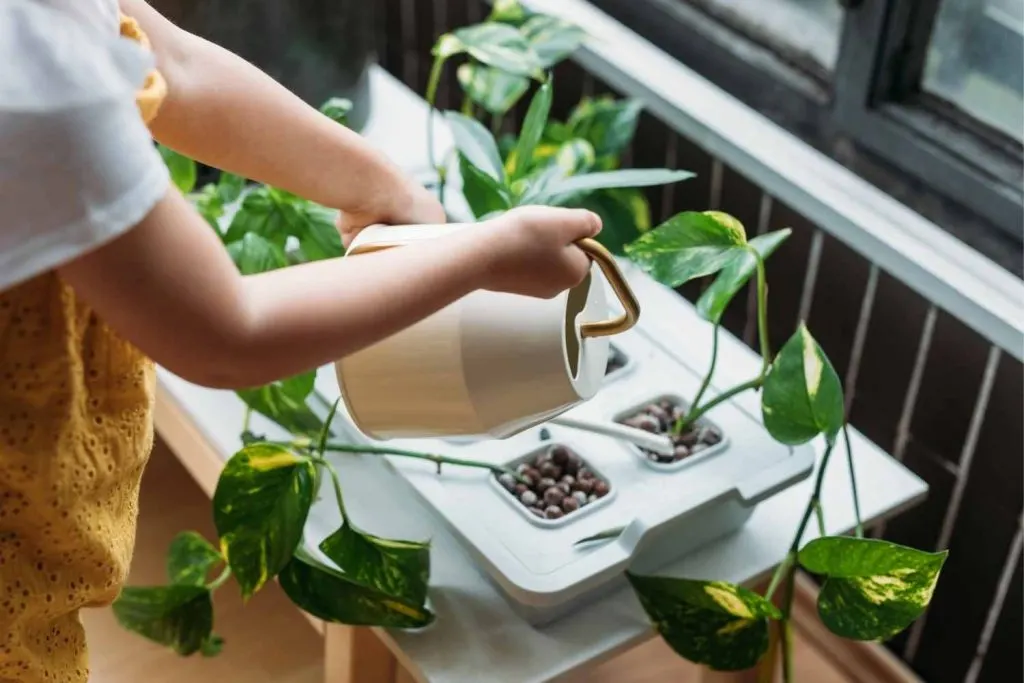
Overwatering Kills The Most Indoor Plants.
When Do your Plants need Water?
Know Your Plants Needs:
Watering needs for indoor plants can vary greatly.
Snake plants Watering frequency can stretch up to 8 weeks. However, Calatheas and other tropicals will absolutely be dead if you put them on a two month watering schedule.
We have printable care guides in our houseplant section for many indoor plants. They each recommend watering frequency for the plant.
For cactus and other dessert plants, Read our Succulents Watering guide. It addresses the particular needs of these water sippers.
Before You Water:
Fortunately, knowing when to water a plant is not as complicated as it might seem. Here’s a few tips.
- check the soil. Is it dry down to the root zone?
- Know your plant. Is this a succulent plant that enjoys dry soil? It is a tropical plant that needs constant, low amounts of moisture?
- Does the plant have Yellowing leaves? (especially lower leaves or new growth) that is yellowing may indicate over watering. Be sure to Check for pests also is leaves look unhealthy.
- Dry, dead or brown leaf tips indicate under watering or too low humidity.
- Are the leaves drooping? A healthy plant with slightly drooping leaves (or leaves that appear slightly shrunken) may be telling you it is too dry. A severely drooping plant is telling you it is in serious trouble. This can happen from severe under or over watering and will end in root rot. A root rotted plant needs attention and help to survive. Here’s how to fix root rot, if it is not too late.
Read our Watering guides on succulents, snake plants and the String of Hearts Plants.
Factors that Impact How Fast your Plant Dries:
Do you have plants that dry out really slowly? Or one or two that dry out really really fast? Some plants will dry out faster than others due to environmental conditions.
Here’s a list of some common variables that impact how often your plants require water. Use these factors to help create your plant watering strategies.
- Planter Materials-terra cotta or unglazed ceramic pots wick water away from your plant. Plastic pots hold water in much longer.
- Pot Size- Is your plant root ball small and sitting in a Too big pot? Large pots of soil hold water if the plant doesn’t need it. This can cause smothered roots that eventually rot. Always use a pot the correct size for your plant root ball.
- Is it root bound in a tiny pot? When a plant outgrows it’s pot the roots get tightly bound. Water cannot penetrate the root ball to hydrate all the roots.
- Does your plant pot have a drainage hole? If not, make one. All pots need a good drainage hole.
- The seasons. Fall and Winter bring drying heat to your plants from heating systems and cold North winds. Learn all out tips on How to Keep your Houseplants Alive in Winter.
- The soil your houseplant is in can trap and hold water or let the water run straight through. Either extreme is going to cause trouble for your plant.
- Hanging plants dry out faster than those set on low shelves or the floor.
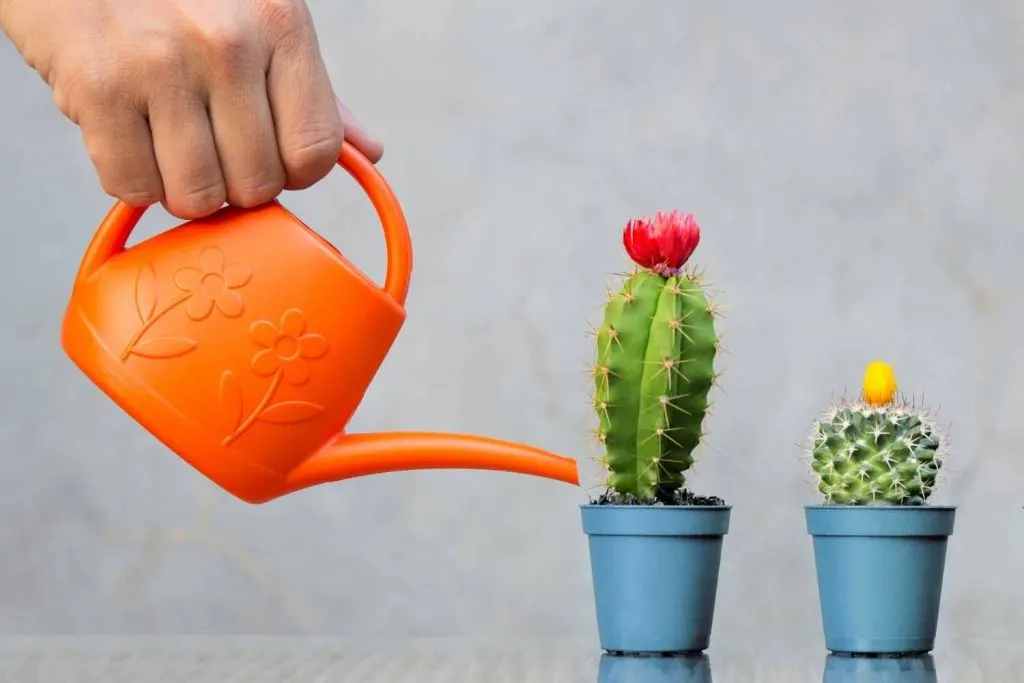
Plant Watering Methods:
There are several ways to water your indoor plants. Bottom watering has some definite advantages. However, top watering works fine in certain circumstances. I have several plants in self watering pots.
Dos and Don’ts: Tips for Watering Plants:
- DO SOAK the plant thoroughly and let the water completely drain out of the pot before putting it back on the plant shelf. Now let it dry to it’s preferred moistness before watering again.
- Do NOT Offer small sips of water frequently from the top of houseplants. The plant roots will have to grow up the to surface of the soil to capture water. This makes for a shallow root ball. You want to encourage roots to grow down into the soil.
- Do NOT let your plant sit in heavy wet soils for long periods of time. This is the road to root rot.
- DO TEST the plant soil for dryness before you water. Most plants like to be dry down to the roots at least an inch before resealing.
- DO Watch for hydrophobic soils. These are soils that are so dry they cannot accept water. When you water plants in hydrophobic soils the water runs down the insides of the pot but never into the roots of the plant. To correct this bottom water your houseplant. This is really a good method for succulents.
- Do use a watering can with a long narrow spout. This will allow you to put water directly where you want it. Some plants do NOT like to get their leaves wet when watered. Some plants are susceptible to leaf viruses. Constantly Wet leaves can spread virus.
Overwatering Or Underwatering?
When your houseplant shows stress it’s smart to consider watering frequency as the problem. Overwatering is THE biggest stresses most plants face.
However, under watering also happens. Plants need water regularly and in the correct amounts.
Here is a Common sense Summary Of how to know if you are over or under watering your houseplants.
Most plants need moderate watering but should never be completely dry or completely wet. If the pot seems light and the leaf tips are brown or the plant collapses, it is getting too little water. If the pot is heavy, the plant droops and the lower leaves turn yellow or brown, reduce watering.
The best test? Insert your finger one to two inches into the soil: If it feels cool and moist, wait to water. Leave about ¾ inch of space between the soil surface and the pot top as a reservoir to prevent spills when watering
WSU Plant Care TIp Sheet
Moisture Meters Help:
I am a serial overwaterer.:) After years of struggling to determine if my houseplants are dry enough for water. I bought a moisture meter. They are very cheap on Amazon.
Many times I think the plant is dry and my moisture meter tells me the root zone is moist or even wet. All the factors discussed above play into this. I have learned a lot about my plants from my moisture meter. Highly Recommend!
I hope this watering guide is helpful. It is the most common issue for our indoor plants health. Please feel free to ask questions in the comment section or let me know if you have more ideas on watering plants.
Related Content:
Follow Us:
Find us on YouTube, Instagram , Pinterest and TikTok! We love to Plant chat. We also comment, like and occasionally share your content to our daily stories. We’d love to see your plants. Share your joy in your houseplants. Happy Planting!
Recent Posts:
- 5 Fantastic Cactus Species for Your Home
- Pygmy Date Palm Trees
- Bromeliad Care Guide and Profile
- Growing Gloxinia Plants in Your Home
- Staghorn Ferns Care and Maintenance
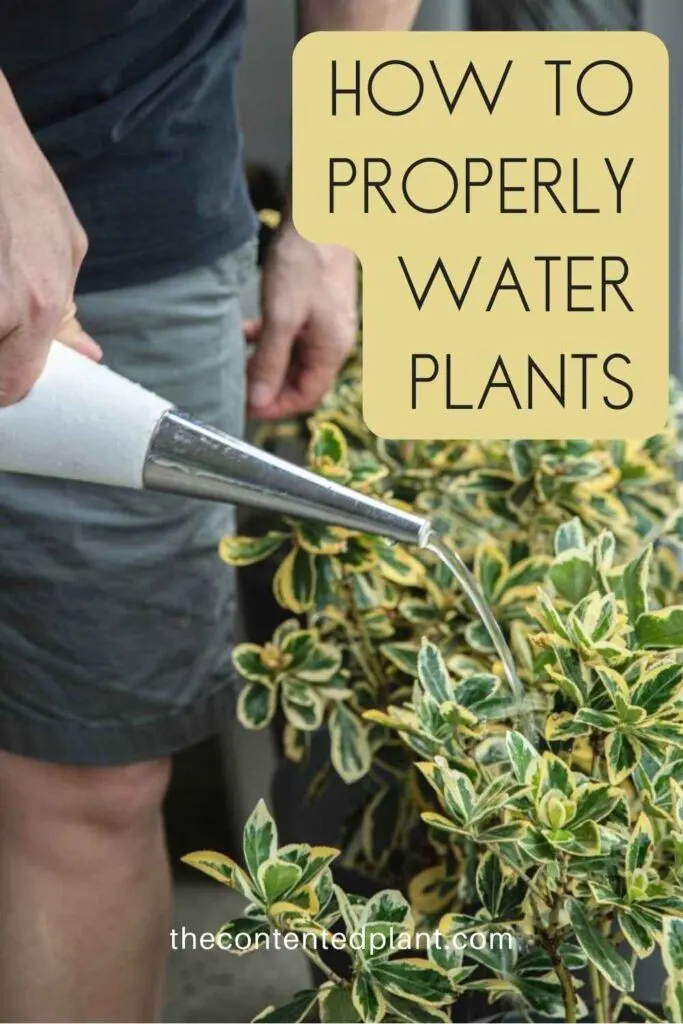

Boston Fern Plant Profile and Care guide - The Contented Plant
Sunday 14th of January 2024
[…] Brown or yellow fronds: If the fronds of your Boston fern are turning brown or yellow, it may be a sign that the plant is not getting enough water or humidity. It could also be a sign of overwatering, hydrophobic soil, pests or a nutrient deficiency. Read this post on watering plants properly for more. […]
Murdannia Loriformis-The Bright Star Plant - The Contented Plant
Tuesday 21st of June 2022
[…] Watering Plants Properly […]
Pothos-Epipremnum aureum-(Devils Ivy) - The Contented Plant
Wednesday 23rd of March 2022
[…] Read Our Complete Watering Guide For Houseplants […]
Mold On Plant Soil-Is it harmful? How to Kill It - The Contented Plant
Sunday 6th of March 2022
[…] Molds grow well on constantly moist soils with poor drainage. Most houseplants do not like constantly wet soils. Are you overwatering? Read our watering guide here. […]
Golden Goddess Philodendron Plant Care Guide - The Contented Plant
Friday 28th of January 2022
[…] is not a particularly difficult plant to grow. The biggest pitfall is watering issues and common pests. With a few tips and tricks you can grow a beautiful golden goddess […]